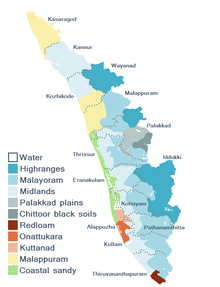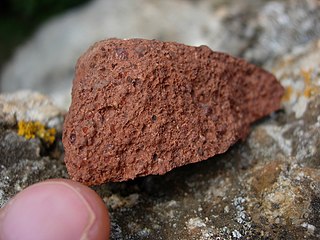
Bauxite is a sedimentary rock with a relatively high aluminium content. It is the world's main source of aluminium and gallium. Bauxite consists mostly of the aluminium minerals gibbsite (Al(OH)3), boehmite (γ-AlO(OH)) and diaspore (α-AlO(OH)), mixed with the two iron oxides goethite (FeO(OH)) and haematite (Fe2O3), the aluminium clay mineral kaolinite (Al2Si2O5(OH)4) and small amounts of anatase (TiO2) and ilmenite (FeTiO3 or FeO.TiO2). Bauxite appears dull in luster and is reddish-brown, white, or tan.

Ultramafic rocks are igneous and meta-igneous rocks with a very low silica content, generally >18% MgO, high FeO, low potassium, and are composed of usually greater than 90% mafic minerals. The Earth's mantle is composed of ultramafic rocks. Ultrabasic is a more inclusive term that includes igneous rocks with low silica content that may not be extremely enriched in Fe and Mg, such as carbonatites and ultrapotassic igneous rocks.

Surguja district is a district of the Indian state of Chhattisgarh. The district is one of the oldest districts of Chhattisgarh. The headquarters of the district is Ambikapur.

Mannarkkad, formerly known as Mannarghat, is a municipal town in Palakkad district of the Indian state of Kerala. The Silent Valley National Park and the Attappadi Reserve Forest are located in Mannarkkad Taluk. Mannarkkad is situated 36 km away from district headquarters Palakkad on National Highway 966.
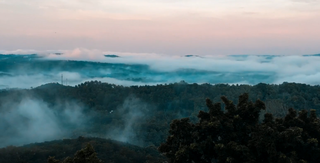
Mankada is a hillside village in the Malappuram district of Kerala state. It is located 15 km (9.3 mi) from Malappuram and is part of the Malappuram parliament constituency. The municipal town of Perinthalmanna is just 10 km (6.2 mi) away. Also, the municipal towns of Manjeri and Malappuram are just 15 km (9.3 mi) away. Mankada Kadannamanna Kovilakam was the seat of ruling family of the erstwhile Kingdom of Valluvanad.

The Indian State of Karnataka is located between 11°30' North and 18°30' North latitudes and between 74° East and 78°30' East longitude.It is situated on a tableland where the Western Ghats and Eastern Ghats converge into the complex, in the western part of the Deccan Peninsular region of India. The State is bounded by Maharashtra and Goa States in the north and northwest; by the Lakshadweep Sea in the west; by Kerala in the south-west and Tamil Nadu in the south and south-east, Andhra Pradesh in the south-east and east and Telangana in the north-east. Karnataka extends to about 850 km (530 mi) from north to south and about 450 km (280 mi) from east to west.

Nilambur–Shoranur line is a 66 kilometres (41 mi)-long single-line, non-electrified broad-gauge (1676 mm) railway spur branch line of the Indian Railways connecting Nilambur Road railway station in Malappuram district with Shoranur Junction in Palakkad district in the state of Kerala. It is a branch line administered by the Palakkad railway division of the Southern Railway zone and one of the shortest broad-gauge railway lines in India. It was laid by the British in colonial era for the transportation of Nilambur Teak logs into United Kingdom through Kozhikode.
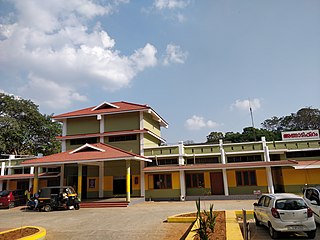
Angadippuram is a major suburb of Perinthalmanna town, in Malappuram District of Kerala. It was the capital of the powerful medieval kingdom of Valluvanad. Angadippuram is also known for Angadippuram Laterite, a notified go-heritage monument. Angadippuram is famous for its two temples, the Thirumandhamkunnu Temple and the Tali Mahadeva Temple. Kozhikode - Palakkad National Highway 966 passes through the town and Angadipuram Railway Station is one of the major railway station on the Nilambur - Shornur Line of Palakkad Division, Southern Railways. It is connected to major cities Kochi and Thiruvananthapuram through this line.

Angadippuram railway station is a major railway station serving the town of Angadippuram in the Malappuram District of Kerala. It lies on the scenic Nilambur–Shoranur line of Palakkad division, Southern Railways. Trains halting at the station connect the town to prominent cities in Kerala such as Nilambur, Shornur, Palakkad, Kottayam and Kochuveli. It is also the nearest railway station to Perinthalmanna (2.5 km) and Malappuram town (20 km).
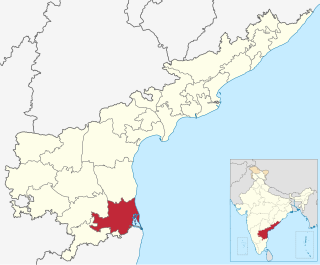
Tirupati Eparchaean Unconformity, a notified National Geo-heritage Monument is a major discontinuity of stratigraphic significance that represents a period of remarkable serenity in the geological history of the earth i.e. sudden changes and discontinuity in the rock layers in earth's crust. It is seen at the steep natural slopes, road scars and ravines in the Tirupati – Tirumala Ghat road in Tirupati district of Andhra Pradesh, India.

Laterite is both a soil and a rock type rich in iron and aluminium and is commonly considered to have formed in hot and wet tropical areas. Nearly all laterites are of rusty-red coloration, because of high iron oxide content. They develop by intensive and prolonged weathering of the underlying parent rock, usually when there are conditions of high temperatures and heavy rainfall with alternate wet and dry periods. Tropical weathering (laterization) is a prolonged process of chemical weathering which produces a wide variety in the thickness, grade, chemistry and ore mineralogy of the resulting soils. The majority of the land area containing laterites is between the tropics of Cancer and Capricorn.
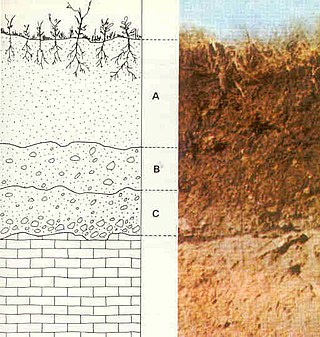
Saprolite is a chemically weathered rock. Saprolites form in the lower zones of soil profiles and represent deep weathering of the bedrock surface. In most outcrops its color comes from ferric compounds. Deeply weathered profiles are widespread on the continental landmasses between latitudes 35°N and 35°S.
Perinthalmanna is a major town and municipality in Malappuram district, Kerala, India. It serves as the headquarters of the Perinthalmanna taluk, and a block and a Revenue Division by the same name. It was formerly the headquarters of Valluvanad Taluk, which was one of the two Taluks in Malappuram Revenue Division of the erstwhile Malabar District during the British Raj. The town is located 23 kilometres (14 mi) south-west to the city of Malappuram at the centre of the Kozhikode-Malappuram-Perinthalmanna- Palakkad National Highway 966.
The 2015 Kerala fireball was a meteor air burst that occurred over Kerala state in India on 27 February 2015.

The transportation in Malappuram district includes road, rail, air, and mass transit.

Pattikkad railway station is a major railway station serving the town of Perinthalmanna in the Malappuram district of Kerala. It lies in the Shoranur–Mangalore section of the Southern Railways. Trains halting at the station connect the town to prominent cities in India such as Nilambur, Shoranur and Angadipuram.

Tuvvur railway station is a minor railway station serving the town of Tuvvur in the Malappuram district of Kerala. It lies in the Shoranur–Nilambur section of the Southern Railways. Trains halting at the station connect the town to prominent cities in India such as Nilambur, Shoranur and Angadipuram.

Vaniyambalam railway station is a minor railway station serving the town of Wandoor in the Malappuram district of Kerala. It lies in the Shoranur–Mangalore section of the Southern Railways. Trains halting at the station connect the town to prominent cities in India such as Nilambur, Shoranur and Angadipuram.
The geology of Liberia is largely extremely ancient rock formed between 3.5 billion and 539 million years ago in the Archean and the Neoproterozoic, with some rocks from the past 145 million years near the coast. The country has rich iron resources as well as some diamonds, gold and other minerals in ancient sediment formations weathered to higher concentrations by tropical rainfall.
The geology of Cameroon is almost universally Precambrian metamorphic and igneous basement rock, formed in the Archean as part of the Congo Craton and the Central African Mobile Zone and covered in laterite, recent sediments and soils. Some parts of the country have sequences of sedimentary rocks from the Paleozoic, Mesozoic and Cenozoic as well as volcanic rock produced by the 1600 kilometer Cameroon Volcanic Line, which includes the still-active Mount Cameroon. The country is notable for gold, diamonds and some onshore and offshore oil and gas.



